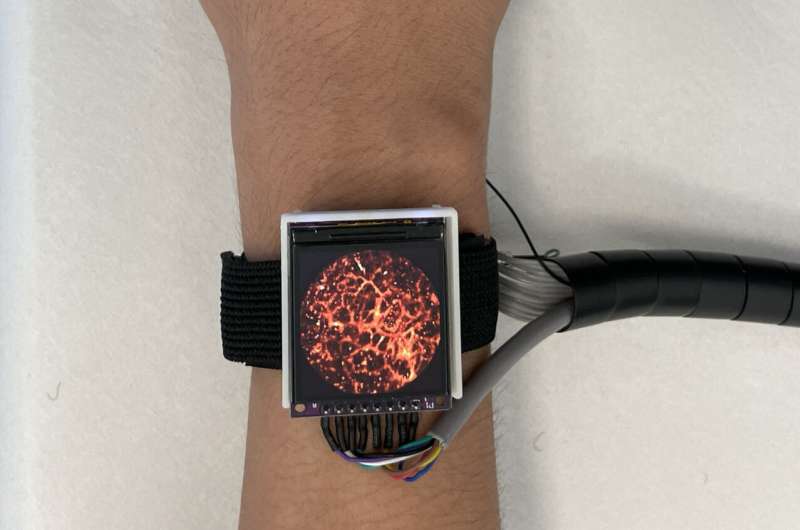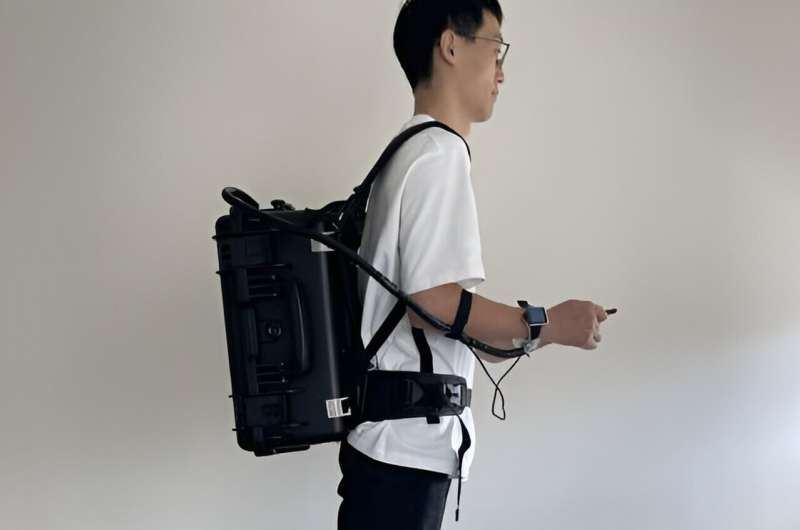This article has been reviewed according to Science X's editorial process and policies. Editors have highlighted the following attributes while ensuring the content's credibility:
fact-checked
trusted source
proofread
Wearable tech captures real-time hemodynamics on the go

Researchers have developed a photoacoustic imaging watch for high-resolution imaging of blood vessels in the skin. The wearable device could offer a non-invasive way to monitor hemodynamic indicators such as heart rate, blood pressure and oxygen saturation that can indicate how well a person's heart is working.
"Although photoacoustic imaging is extremely sensitive to variations in hemodynamics, difficulties in miniaturizing and optimizing the imaging interface have limited the development of wearable photoacoustic devices," said research team leader Lei Xi from the Southern University of Science and Technology in China. "To the best of our knowledge, this is the first photoacoustic wearable device that is suitable for health care applications."
In Optics Letters, the researchers describe their new system, which consists of a watch with an imaging interface, a handheld computer and a backpack housing the laser and power supply. Tests with volunteers moving freely showed that the device can be used to observe blood flow variations during different activities, such as walking.
"Miniaturized wearable imaging systems like the one we developed could potentially be used by community health centers for preliminary disease diagnosis or for long-term monitoring of parameters related to blood circulation within a hospital setting, offering valuable insights to inform treatments for various diseases," said Xi. "With further development this type of system could also be helpful for the early detection of skin conditions such as psoriasis and melanoma or for analyzing burns."
Creating a wearable imager
Photoacoustic imaging is a label-free technique that forms images by measuring light-induced sound waves created by light absorption in structures. Analyzing the photoacoustic signal intensity and distribution offers insights into the functional and structural characteristics of microvessels, which can be altered by various diseases.
Although photoacoustic imaging is still primarily a research tool, it is beginning to find clinical application in areas such as cancer, vascular, and dermatological imaging.
To turn what is typically a bulky instrument into something that could be worn while moving around, the researchers developed a compact optical resolution photoacoustic microscopy system based on a compact pulsed laser, tight fiber-based light path, and an integrated electronic system housed in a backpack weighing 7 kilograms.
They also designed a handheld device to store the images and created a miniaturized watch-type imaging interface with an adjustable focal plane and a screen display for displaying the images in real-time.
The researchers designed the system so that it could be used for imaging while the wearer is freely moving around. It also features an adaptable laser focus, which is necessary for imaging multilayered structures like skin. The photoacoustic imaging system has a lateral resolution of 8.7 µm, which is sufficient to resolve most microvessels in the skin, and a maximum field of view of around 3 mm in diameter, which is adequate for capturing microvascular details.

Tracking blood on the move
The researchers tested the device with volunteers to evaluate the focus-shifting function of the watch and the system's capacity to detect blood flow changes over an extended time under different conditions, such as while the wearer was walking and when a cuff was used to block blood flow to the arm temporarily. These tests showed that the system is usable, compact, and stable enough to allow free movement.
The researchers are now working to create a system that employs an even smaller laser source with a higher repetition rate. This will make the system more compact and lighter while also enhancing safety and temporal resolution. "Given the rapid development of modern laser diode technology and electronic information technology, it should be entirely feasible to develop a more advanced and intelligent photoacoustic watch that doesn't require a backpack," said Xi.
The researchers are also working to ensure the stability of the fiber-coupled optical path over extended periods and under more intense conditions such as running and jumping.
They also want to incorporate multispectral illumination, which would allow the acquisition of additional physiological parameters, including oxygen saturation and blood flow velocity, and the quantitative assessment of parameters such as vessel number and volume. These capabilities could help support early diagnosis of conditions such as cancer and cardiovascular diseases.
More information: Ting Zhang et al, Wearable photoacoustic watch for humans, Optics Letters (2024). DOI: 10.1364/OL.514238



















